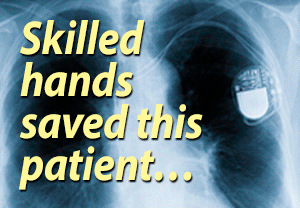 How many catheters used in AV ablation
How many catheters used in AV ablation
- by pogerm1
- 2022-12-03 18:09:32
- General Posting
- 550 views
- 9 comments
Can you ask your pm club how many catheters they had for their av ablation? They are incisions in the femoral vein in which the catheter is inserted to the heart. Natale used 4, this guy 1.
Can you ask if it’s set to 80 then after an av ablation shouldn’t it never pass 80? Isn’t that the reason for the av ablation? To allow the pm to determine my pulse rate? Mine is fast to 104.
The above was questions that a friend of mine wonders if anyone would answer.
Thank You
9 Comments
AV ablation
by AgentX86 - 2022-12-03 21:59:26
I had two catheters, one through the groin to burn out the AV node and another usually through the subclavian vein to fish the leads. Mine was done all at once but often these are separate procedures.
The idea of the AV node ablation is to destroy the AV node. The object of an Afib or Aflutter ablation is to burn out the errant path without touching the AV or SI nodes. During an AV node ablation, if the probe burns somewhere else, "oh well", the atrium (usually) won't be useful anyway. OTOH, if during a normal ablation, of the probe touches the SI or AV nodes, its an "OH $#!T". The source of the arrhythimia has to be found (hard) and ablated. It's a much more complicated operation.
AV ablation
by pogerm1 - 2022-12-03 23:01:12
Thanks to both replies, i will forward your answers to my friend. She has had 3 ablations, a watchman and now an AV node ablation, she is stll having some fast heart rates and wonders why she should be having this after her AV node ablation.
AV ablation thread
by Shementush - 2022-12-04 03:21:44
I joined and this is my first post. Thank you Pogerm1 for posting my question in my behalf and for those of you who replied.
I'm currently set to pacing at 80 but if I walk around my HR can jump to 104. My EP speculated inflammation from my av ablation two days ago is causing my temporary higher HR. My PM is set to 80. Prior it was always 70.
I just need some clarity on HR after an AV ablation. I was under the impression once I get my AVNA I would never get my high HR tachy again (120s to 200hr) and my PM will take over and pace 100% at my PM set 80hr rate. Before my AVNA I had 98% A pacing and .09 V pacing.
My EP said my higher HR is due to inflammation and it will go down in a month (blanking period?). I'm curious on how my HR can exceed my settings of 80 hr? Ventricular HR?
Last question is regarding pacing cardiomyopathy. If my EF declines from ventricular pacing, I'll get a third lead so both ventricular chambers will have leads. My last question (for now) is would I need a larger Metronics PM down the road?
thanks in advance. Im not a newbie to my PM, just questions about my two day old AV node ablation.
Pogermi1 and Shementush
by Gemita - 2022-12-04 04:43:03
The AV Node is not a perfect procedure, since it doesn’t cure the atrial tachy arrhythmias which will still continue in the atria, however the speed and any irregularity of rhythm should not be felt since these signals can no longer pass through the AV Node to affect the ventricles.
Once we become pacemaker dependent we will need a setting called Rate Response turned on. Rate adaptive pacing is necessary following AV nodal ablation, to allow for pacing rate increases in response to higher energy demands. Perhaps this is where the higher rates are coming from as well as coming from an inflamed, healing heart? The healing period may last for several months since heart tissue has been traumatised. Our autonomic nervous system may play a part too and it has to be said that ventricular arrhythmias are also still possible following an AV Node ablation. A pacemaker will prevent a drop in the lower rate limit setting, but it cannot stop your ventricular rate from increasing due to say a ventricular arrhythmia, the healing process, or due to Rate Responsive settings.
Also, I do not know whether either of you have single or dual chamber pacing? A decision for single or dual chamber pacing depends on whether the patient has periods of sinus rhythm. The patient with paroxysmal AF and periodic sinus rhythm may still benefit from a dual-chamber rate-adaptive (DDDR) pacemaker in order to maintain some AV synchrony. DDDR pacemakers for this purpose have automatic mode-switching capability to avoid rapid ventricular pacing during episodes of AF. However, patients with permanent chronic AF usually do not benefit from the addition of an atrial lead (due to lack of sinus rhythm) and require only a single-chamber device with rate-adaptive capabilities.
Rate Response settings can be difficult to get right for each patient. It will take time to optimise and you should work with your technician until you feel comfortable. A heart rate of 80 bpm might be fine for a resting heart rate but when activities like walking, climbing stairs are attempted, you will need Rate Response to allow for pacing rate increases in response to higher energy demands.
No one can answer whether you will need a CRT pacemaker down the road or if you will develop cardiomyopathy from Right Ventricular pacing since each patient will have their own unique health conditions. While a high % of right ventricular pacing may lead to heart failure symptoms in some patients, it certainly doesn’t affect everyone the same way. Clearly though dyssynchronous pacing is not good for us and some patients get a CRT pacemaker from the start to try to prevent this.
I wish both of you well
Thanks
by Shementush - 2022-12-04 13:35:48
I had rate response set on before my ablation because walking would give me 133-150 atrial tachycardia. I don't know what the setting is now. It was DDDR. I read all my interrogation reports (scheduled every 3 months automatically from my cell phone app) and noticed my highest rate was once 303 and another time 306. But usually it was in the 130s to 150s. My PM had a success at 86% to convert but not the 1:1 tachycardia I had lately.
I was told to get this permanent av nuke because I would no longer have to stay admitted weekly for uncontrollable flutter or atrial tachycardia, discharged for a few days and repeat. From thanksgiving 2021 to January 2022 I was admitted weekly for 3-4 days, home for 3-4 days and returned to get admitted again. This past month the same pattern resumed. I lived basically in the hospital. Nobody ever told me that my tachycardia can return after an AVNA.
I have an Azure dual chamber Medtronics PM. My rate response was set to 132 as my high and burst therapy added.
After an AV Node ablation
by Gemita - 2022-12-04 13:50:25
Shementush, after an AV Node ablation, fast arrhythmias coming from the atria cannot cause the ventricles to ever go fast again because of the AV Node block, that you can be sure about with a successful AV Node ablation. But you will need to get your heart rate up sometimes with exercise and Rate Response will do that.
You would be very unlucky to suffer from a ventricular arrhythmia but I had to mention this because of course ventricular ectopics may still occur and trigger other ventricular stuff.
A healing period is very common though and so normal and I feel very confident that all will be well very soon. I too have a Medtronic dual chamber (Ensura) and my husband also, although he has a single lead to his right ventricle because of persistent AF
Tachycardia after AV ablation
by AgentX86 - 2022-12-04 18:23:55
You shouldn't be able to feel anything that your atria are doing. Take your pulse manually (at least 30 seconds). If your resting heart rate is above its setting (or above 100), there are only a few possibilities.
- Your pacmaker is set up to do the mode switch from DDDx to VVIR when an arrhythmia is detected. ...and it's not working
- Your AV ablation was unsuccessful
- You have a ventricular arrhythmia. I would assume your EP would notice this immediately and you'd find yourself back in the hospital, quick like.
- I suppose there is a possibility of an accessoory electrical path other than the AV node, the sort of thing that would cause Wolf-Parkinson-White.
IOW, "This can't happen.". 😉
Symptomatic arrhythmias
by Shementush - 2022-12-05 22:44:52
Thanks AgentX86. I do have an IWatch plus a 6L Kardia so I know my hr and see my rhythm when I feel an extra beat. I do check my watch if I'm feeling arrhythmia . Force of habit. I'm noticing PVCs which maybe is what I'm feeling. PVCs were common for me during my first three afib ablations.
I was hooked up to telemetry my entire hospitalization so I'm confident my EP saw my rhythm.
My PM settings could had been tweaked during the av ablation so I have to wait for the interrogation report to see what it is now. It used to be in mode AAIR<=>DDDR. All I know is I'm pacing at 80 which used to be 70.
You know you're wired when...
You can proudly say youre energy efficient.
Member Quotes
Good luck with your surgery. It will improve life amazingly.


.png)


AV Node ablation
by Gemita - 2022-12-03 20:59:08
I don’t think we are comparing like with like? I am assuming the four catheters used by Dr. Natale was for a regular pulmonary vein isolation ablation (PVI) which is far more complex to carry out and can last for hours and may not always be successful first time, whereas a simple, albeit rather final AV Node ablation, is rather quicker and simpler to perform.
From what I recall when I was considering this type of ablation, they use one catheter (?), the procedure takes little over 15-30 mins, is usually 100% effective on first attempt (unlike regular PVI ablation which may need touching up) and has a low risk for complications (less than 1-2%).
Immediately after an AV Node ablation they usually set the lower rate limit higher to around 80-90 bpm while the heart is healing. They set it higher to protect the patient from the potential risk of sudden cardiac death immediately following ablation of the AV Node, decreasing this higher rate gradually over a few months as the heart settles. With this slightly higher setting, it can be expected that the ventricular rate will be higher than this lower limit at times. I suggest you tell your friend to speak to her doctors to see whether a heart rate slightly over 100 bpm (definition of tachycardia) is okay or whether she will need a low dose med to calm things down. I suspect not but member AgentX86 will hopefully see your message and help me out here since he has had an AV Node ablation.
The purpose of the AV Node ablation is to disconnect the upper chambers from the lower chambers, to prevent fast AF and other atrial tachyarrhythmias from passing through the AV Node to push the ventricles too fast. However should an arrhythmia occur in the ventricles, this will still need to be treated. At this point though I suspect this slightly higher heart rate will be fairly normal while healing is taking place.
I hope you are well Pogerm1. I remember you helped me when I first came to this site asking a question on “nocturnal tachycardia”. Cannot believe all those years have passed